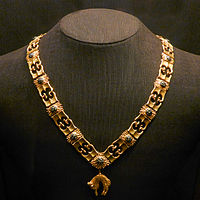Order of the Golden Fleece
| Order of the Golden Fleece Orden del Toisón de Oro Ordre de la Toison d'Or Orden vom Goldenen Vlies Ordo Velleris Aurei |
|
|---|---|

Chain of the Order of the Golden Fleece (shown in the Schatzkammer in Vienna)
|
|
| Awarded by the King of Spain and the Head of the House of Habsburg |
|
| Motto |
Pretium Laborum Non Vile Non Aliud |
| Awarded for | At the monarch's pleasure |
| Status | Currently constituted |
| Sovereign |
Felipe VI of Spain Archduke Karl of Austria |
| Grades | Knight |
| Statistics | |
| Established | 1430 (see History) |
The Order of the Golden Fleece (Spanish: Orden del Toisón de Oro,German: Orden vom Goldenen Vlies) is a Roman Catholic order of chivalry founded in Bruges by Philip III, Duke of Burgundy in 1430, to celebrate his marriage to the Portuguese princess Infanta Isabella of Portugal, daughter of King John I of Portugal. It became one of the most prestigious orders in Europe. Today, two branches of the Order exist, namely the Spanish and the Austrian Fleece; the current sovereigns are Felipe VI, King of Spain, and Karl von Habsburg, grandson of Emperor Charles I of Austria, respectively. The chaplain of the Austrian branch is Cardinal Graf von Schönborn, Archbishop of Vienna.
The Order of the Golden Fleece was established on 10 January 1430, by Philip the Good, Duke of Burgundy, in celebration of the prosperous and wealthy domains united in his person that ran from Flanders to Switzerland. It is restricted to a limited number of knights, initially 24 but increased to 30 in 1433, and 50 in 1516, plus the sovereign. The Order's first King of Arms was Jean Le Fèvre de Saint-Remy. It received further privileges unusual to any order of knighthood: the sovereign undertook to consult the order before going to war; all disputes between the knights were to be settled by the order; at each chapter the deeds of each knight were held in review, and punishments and admonitions were dealt out to offenders, and to this the sovereign was expressly subject; the knights could claim as of right to be tried by their fellows on charges of rebellion, heresy and treason, and Charles V conferred on the order exclusive jurisdiction over all crimes committed by the knights; the arrest of the offender had to be by warrant signed by at least six knights, and during the process of charge and trial he remained not in prison but in the gentle custody of his fellow knights. The order, conceived in an ecclesiastical spirit in which mass and obsequies were prominent and the knights were seated in choirstalls like canons, was explicitly denied to heretics, and so became an exclusively Catholic award during the Reformation. The officers of the order were the chancellor, the treasurer, the registrar, and the King of Arms, or herald, "Toison d'Or".
...
Wikipedia
